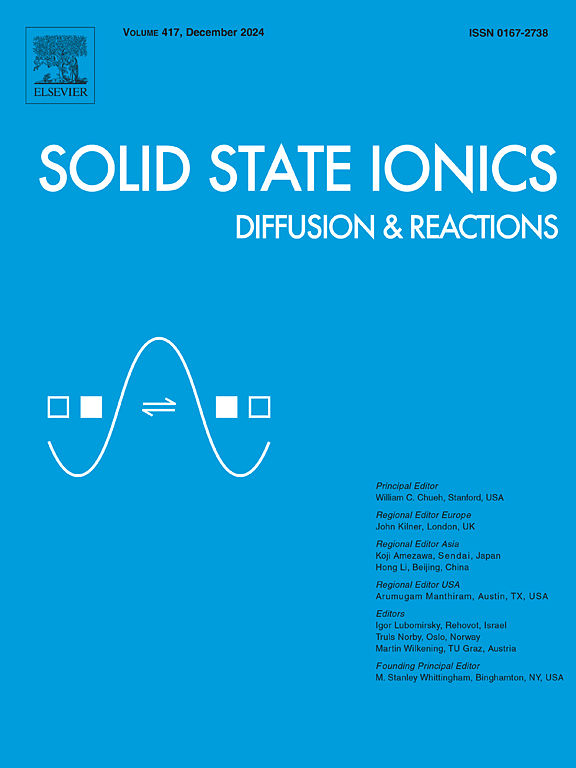Economical, ecofriendly and easy to handle polymer-in-salt-electrolyte
IF 3
4区 材料科学
Q3 CHEMISTRY, PHYSICAL
引用次数: 0
Abstract
Polymer-In-Salt-Electrolytes (PISEs) are an emerging branch of polymer electrolytes which are supposed to address the shortcomings (slow ion movement due to polymer coupled motion and small cationic transference number) of Salt-In-Polymer-Electrolytes (SIPEs), but a PISE, which may be commercially used for fabrication of energy device is still a dream because of recrystallization and brittle matrix at higher salt concentration. Our group has developed a simple solution casting protocol for synthesis of an economical, eco-friendly and easy to handle PISEs from crosslinked starches, where there is no need of getting the molten state salt/salt-mixture. The thought process behind this protocol and selection of starch as host polymer is that the salt breaks the starch into smaller molecules resulting in generation new –OH and –H to interact with salt, i.e. increasing salt concentration itself creates a favorable atmosphere for its acceptance. Starch is hydrophilic in nature and presence of large amount of salt adds up to it, and such materials have moisture content varying from ∼5 % to 25 %, depending to salt and starch combination and concentration, which is a favorable property leading the synthesized PISEs to behave as Water-In-Polymer-Salt-Electrolytes (WiPSEs). By exposing the freshly synthesized samples to high humidity these materials were stabilized with respect to ambient humidity changes. These materials lead to ESR <10 Ω (reaching to as low as <1 Ω), wide electrochemical stability window (ESW > 2.5 V) and ion relaxation time is of the order of μSec. The supercapacitor fabricated using synthesized PISEs with commonly available supercapacitor electrodes have behavior at par with other electrolytes reported in the literature. With lab-synthesized activated carbons, a capacity of ∼125 F/g has been obtained with columbic efficiency >98 %. Since the synthesis protocol and chemicals used are economical, the starch-based PISEs are economical and also environment benign, because starch is a renewable polymer and the process uses only one extra chemical (methanol as solvent). The material is flexible and can be molded in the desired shape and size and hence is a potential candidate to reach at the commercial level, if explored in detail.
经济、环保、易于处理的盐电解质聚合物
聚合物-盐电解质(PISEs)是聚合物电解质的一个新兴分支,旨在解决盐-聚合物电解质(SIPEs)的缺点(由于聚合物耦合运动导致离子运动缓慢和阳离子转移数小),但由于高盐浓度下的重结晶和基体脆性,PISE可能用于商业制造能源装置仍然是一个梦想。我们的团队开发了一种简单的溶液铸造方案,用于从交联淀粉中合成经济,环保且易于处理的pses,其中不需要获得熔融态盐/盐混合物。这一方案和选择淀粉作为宿主聚合物背后的思想过程是,盐将淀粉分解成更小的分子,从而产生新的-OH和-H与盐相互作用,即增加盐浓度本身就为其接受创造了有利的环境。淀粉在本质上是亲水的,大量的盐加在一起,这些材料的水分含量从~ 5%到25%不等,这取决于盐和淀粉的组合和浓度,这是一个有利的性质,导致合成的pise表现为聚合物-盐电解质(wipse)中的水。通过将新合成的样品暴露在高湿环境中,这些材料相对于环境湿度的变化是稳定的。这些材料导致ESR <;10 Ω(低至<;1 Ω),宽电化学稳定窗口(ESW >;2.5 V),离子弛豫时间为μSec数量级。利用合成PISEs和常用的超级电容器电极制造的超级电容器具有与文献中报道的其他电解质相同的行为。使用实验室合成的活性炭,获得了约125 F/g的容量,哥伦比亚效率>; 98%。由于合成方案和使用的化学物质是经济的,淀粉基PISEs既经济又环保,因为淀粉是一种可再生聚合物,而且该过程只使用一种额外的化学物质(甲醇作为溶剂)。这种材料是柔性的,可以被塑造成所需的形状和尺寸,因此,如果详细探索,它是达到商业水平的潜在候选者。
本文章由计算机程序翻译,如有差异,请以英文原文为准。
求助全文
约1分钟内获得全文
求助全文
来源期刊

Solid State Ionics
物理-物理:凝聚态物理
CiteScore
6.10
自引率
3.10%
发文量
152
审稿时长
58 days
期刊介绍:
This interdisciplinary journal is devoted to the physics, chemistry and materials science of diffusion, mass transport, and reactivity of solids. The major part of each issue is devoted to articles on:
(i) physics and chemistry of defects in solids;
(ii) reactions in and on solids, e.g. intercalation, corrosion, oxidation, sintering;
(iii) ion transport measurements, mechanisms and theory;
(iv) solid state electrochemistry;
(v) ionically-electronically mixed conducting solids.
Related technological applications are also included, provided their characteristics are interpreted in terms of the basic solid state properties.
Review papers and relevant symposium proceedings are welcome.
 求助内容:
求助内容: 应助结果提醒方式:
应助结果提醒方式:


